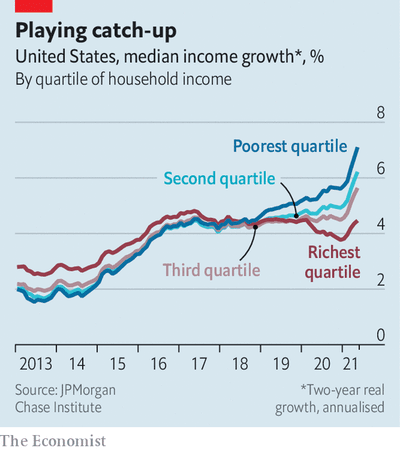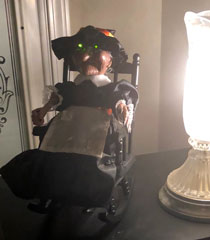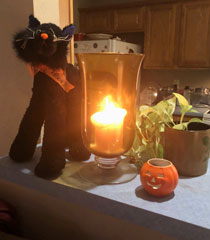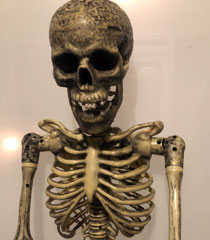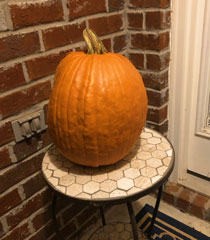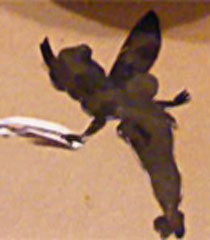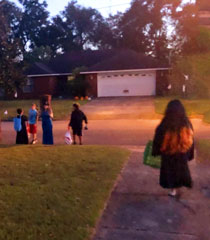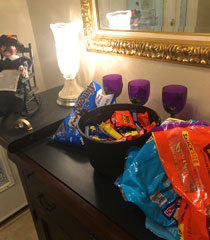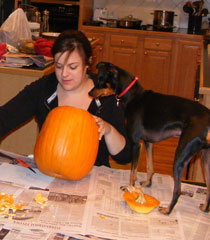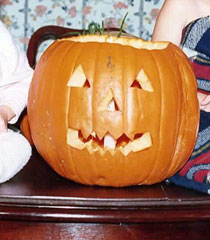 |
The Skarry Skelly 2021 Halloween Message |
|
Hey kids! Is it almost over, or is this just another calm before another storm? |
M
any people think Halloween is just that time of year when the kids fill the streets and the Budweiser goes on sale. But it's really so much more. In the U.S. at least, when God wants to take the temperature of our national mood, Halloween is where he sticks the thermometer. And what he's learning this year is that we're mad as hell and not going to take it anymore. The world may still be in the suffocating grip of a deadly worldwide pandemic, with nearly 5 million dead, but America is rearing up to strike back. Our way of doing that is by acting in ways that ignore our own best interests and spending a whole lot of money. Masks are for kids, except in school, to hell with social distancing, to hell with vaccinations. Fauci is a malevolently crazed and, at the same time, witless tool secretly on the payroll of big pharma. We're taking horse deworming medicine and demanding vaccine only when we're already deathly ill. And, failing in that, we want monoclonal antibodies, the cost of which is about $2,100 per pop, or "jab" as they like to say. (A dose of COVID-19 vaccine costs about $20.) This Halloween we're fixing to spend an all-time record $10.14 billion on candy, costumes, decorations and party favors to take our collective mind off our troubles and, as Billy Joel put it, forget about life for a while. That ought to fix it. Enough already! The National Retail Federation’s annual survey (conducted by Prosper Insights & Analytics) predicts Halloween spending this year will be up a whopping 26% from last year. Well, Lord knows, we have the money, or at least appear to think we do. How could that be, you ask? Has not this year so far given us such a miserable economic, not to mention medical, working over? Ah, but while the latter was certainly true (even though from its origins, only 14% of us have ever caught this virus—but that's another story), the former was only true for the small portion of us who lost our hours, our jobs, our businesses or our houses. Most of us are doing just fine economically—which is not the same thing as enjoying a fine quality of life. A majority of us suffered little or no loss of income and saw our expenses decline significantly due to COVID. For months, we couldn't do anything, go anywhere or even buy anything—at least not until we figured out we could turn our weary eyes to Amazon.com, and realized that Uber et al were in the food delivery business. Many of us are sitting on a pile of cash right now. And evidently we intend to weaponize it. Ask your friends in the 1% club how they made out last year. What with growing vaccination numbers and declining viral cases, more businesses reopening, a generous infusion of federal aid and more people working (yes, jobs never actually stopped growing), the economy was expected to expand by around 7% this year, giving us the fastest calendar-year growth since 1984. However, this last COVID surge put a pretty good crimp in our growth surge. Third quarter GDP came in at last week at 2.0%, down from 6.7% the previous quarter. So, a little less wind in our sails now as we sail into the new year. We'll have to see what it does to spending. The professional outlook is gloomy. PCE growth is what took the hit in the third quarter (That's "Personal Consumption Expenditures"), with growth dropping from 12% down to 1.6% (from $382.9 billion to $53.7 billion). But the COVID surge is going down as fast as it went up, and people have short memories. The Atlanta Fed's GDP Now 4th Qtr. projection right now is at 6.6%. That seems aggressive. But if it holds up, annual GDP growth for 2021 is likely to be the highest since 1984 even with the bad third quarter. You don't hear people mentioning that. Maybe Christmas presents won't be quite so hard to come by after all. Then again, maybe not. As to inflation, Stephanie Ruhle of MSNBC, who is smarter than her wardrobe or hair styles would suggest, recently pointed out on-air that, shortages and inflation worries notwithstanding, people did seem to be buying everything in sight. What did they think was going to happen to prices, she wondered? If buying does slow, so should inflation. Going out on a limb here, just like Bill Murray, but I'm predicting neither will. As American consumers stepped up their spending, they started consuming physical goods more and services less, what with airline tickets, vacations, restaurant outings and even haircuts so inconvenient to come by. Spending on goods accelerated at an annual pace of nearly 24% in the second quarter; services spending rose at a rate below 5%, according to AP reporting. Even poor people's salaries started going up. Check out the following, from The Economist. According to the most recent Bureau of Labor report, there are now more jobs available in the U.S. than workers to fill them.
As for new-wave amateur economists who like to think the stock market, rather than economic growth, is the proper scorecard for charting an economy's ups and downs, you'll want to note the Dow Jones Industrial Average is up 16.7% so far this year, surge or no. Former President Donald Trump can take some credit for that. And surely he will. The DJIA had an annualized return of nearly 11.8% under Trump, third-best performance going back to the 15 presidents who preceded him. He won't like this part: he trails only Obama (12.1%) and Clinton (15.9%). Calvin Coolidge, with the benefit of the Roaring ’20s, topped them all with a 25.5% annualized gain. (Cautionary note: past performance no guarantee of future results. Commit the following to memory so it need not be repeated again: Presidents don't make or break markets, the markets make or break the presidents. Shingles isn't the only thing that doesn't care.)
Latex Halloween masks that look like the lumpy molecules of the SARS-CoV2 virus remain popular in 2021, some going for as much as $79. Political costumes have lost some appeal this time around, succumbing to fictional superheroes. Oh yes, and Michael Myers (see below). So have yourselves a Happy Halloween, guys. Spread some cash around. Probably won't run into you in the bars this year either, unless you're crawling the Panhandle. Even then, unlikely. Remember to watch yourselves on the streets. It's not just the undead wandering around out there with bad judgement and short fuses. Love, |
 websitesammy home page |
|
'Halloween Kills' latest movie to hit big at the box office post pandemic
Oct 18, 2021
By Staff, News 12 New Jersey The latest film in the "Halloween" franchise killed at the box office this weekend. "Halloween Kills" made $50 million in its opening weekend, the film helping theaters in New Jersey slash their way back from the COVID-19 pandemic.
"It shows that the movie theater industry is on its way back," says Doreen Sayegh, owner of Cranford Theater. The adventures of Michael Myers is not the only horror movie to hit it big at the movies recently. Over the summer, "A Quiet Place Part 2" became the first successful blockbuster since the pandemic, followed by "The Conjuring: The Devil Made Me Do It," and "Venom: Let There Be Carnage." "It’s one of those things where you can really escape reality and jump into whatever is on the screen," Sayegh says. "Whether it scares you or makes you laugh or makes you cry. Horror is definitely a genre that people love." With well over 100 movie theaters in New Jersey and Halloween being the season for horror, it may be a turning point for movie theaters on their way to a comeback. The Cranford Theater is expanding its offerings to include screenings of horror classics in the lead-up to Halloween. Among them, "Nightmare On Elm Street," the original 1978 "Halloween" and the documentary "Boris Karloff: The Man Behind the Monster."
New York City's Village Halloween Parade comes back to life, saved by a serious fan
Oct 29, 2021
Jon Kalish, NPR, Heard on Morning Edition Many municipalities around the country have allowed large-scale Halloween gatherings to take place this year, after forbidding them in 2020 as a public health precaution prompted by the pandemic. Likely nowhere is this being greeted with as much enthusiasm as in New York City, where the Village Halloween Parade is one of the city's largest, most colorful cultural events of the year. Described as New York's version of Carnival, the parade provides a major economic boost to Lower Manhattan every year.
Before last year, the only other time the Village Halloween Parade was canceled was in 2012, when it had to be scrapped in the wake of Superstorm Sandy's devastation. Even the terrorist attacks on 9/11 didn't stop the costumed marchers from making the trip up Sixth Avenue just seven weeks later. Covering that parade, I was reminded that you never know who will show up. I couldn't help but notice a Brooklynite marching with his pet goat, which was completely covered with MetroCards, the wallet-size plastic passes New Yorkers use for subway entry. "He's MetroGoat," the Brooklynite told me, "and I'm MetroMan: able to leap over a turnstile in a single bound!" Whether any goats will be hoofing it this year remains to be seen when the parade steps off in Soho on Sunday night, headed up to Chelsea, a few blocks north of Greenwich Village. But the 1959 Cadillac ambulance used in the movie Ghostbusters – a.k.a. The Ectomobile – will be tooling up the avenue, along with 10 taxi cabs dressed up to look like it. As in years past, there will be giant puppets, marching bands, floats and thousands of costumed marchers. Jeanne Fleming, for 40 years the parade's artistic director, didn't learn that this year's event was on until mid-September. "I had no idea," Fleming says. "Like everyone else, we were waiting to hear what's going on with COVID, what's possible." When city officials gave the go-ahead, Fleming scrambled to find sponsors, and instituted a crowdfunding campaign. Less than 200 people contributed a mere $10,000: a sum that disappointed Fleming, given the huge number of people who turn out to watch the parade. In late September she sent out an email warning that unless she could raise $150,000, the parade would be canceled. And then, a 54-year-old financial advisor, who's been attending the parade since he was a teenager, made a $150,000 tax-deductible donation, effectively saving the parade. "I was just trying to do something nice for the city I love," says Jason Feldman, a Manhattanite. "Hopefully, it's a great turnout and, hopefully, lots of spectators." In early October, Feldman made the two-hour drive north to Rokeby, the 300-acre historic estate in Red Hook, N.Y., where Fleming lives and produces the parade. Set along rolling hills next to the Hudson River, Rokeby is also where some of the giant puppets for the parade are created. A Buddhist monk who lives on the estate is lending Feldman a monk's robe to wear as he marches alongside Fleming in front of the parade. Fleming joke that the financial adviser could've dressed up as a knight in shining armor. But Feldman, a practitioner of Tai Chi, is opting for the Zen look, which includes sandals and a staff. Every October volunteers, many from New York City, arrive on the weekends to help build giant puppets in what has come to be known as a puppet raising. Some of the work is done on the estate in an old dairy barn with a 30-foot ceiling. The parade's theme this year is Let's Play, dedicated to New York children who didn't have a proper Halloween last year. The giant puppets are based on drawings submitted by kids. Patricia Valdez, who drove to Rokeby from her home in Harlem, was busy on a recent weekend, glue gun in hand, building part of a puppet out of cardboard. Valdez has been going to the puppet raising at Rokeby since 2016, and also marches in the parade, carrying one of the giant puppets. "I like being part of something creative and I like that it's getting back into the community," she says. "When you're in the parade, you're seeing smiling faces, you're seeing awe. And how can you not feel good, knowing that you had something to do with that?" The parade's COVID precautions this year are twofold. Marchers have been asked to wear medical masks while they're waiting in the staging area, but can take them off once they start on the mile-long walk uptown. Spectators along what is usually a packed Sixth Avenue are urged to wear masks, since social distancing is basically impossible. Many spectators wear costumes, often including a non-medical mask. In years past, more than two million parade watchers have jammed the sidewalk along the parade route. "One of my favorite puppeteers is not coming, because she doesn't feel safe," Fleming notes. "Other people are not concerned at all." Attitudes, she notes, span "the entire gamut of everything the nation is feeling." Fleming said she decided to select comedian Randy Rainbow as this year's grand marshal because his YouTube song parodies kept the nation laughing throughout the pandemic. Fleming admits the satirist scored major points when he released "Mr. Biden," a video parody of "Mr. Sandman" including lines like: Mr. Biden, bring my vaccine
I want to trick or treat when we hit Halloween. Rainbow, adorned in a specially made rainbow coat and his trademark pink glasses, will ride along with six dancers on a float designed by Richard Prowse, a retired Broadway set designer. Feldman calls the parade "the best medicine for our city." "People get to be themselves, maybe the most extreme versions of themselves, wherever their imagination takes them version of themselves," he says. "They don't judge, they don't expect to be judged. And that's indicative of what makes our city a wonderful place." Adds Fleming, "It's the night that people get to come out and tell their stories, whatever their story is. That's the role that it plays. Can you imagine two years of shutting ourselves in, without having this night of celebration?" That would be pretty scary, indeed. |
It’s Hard to Enforce Pandemic Health Rules on Halloween. Just Look at What Happened in 1918
Oct. 28, 2020
By OLIVIA B. WAXMAN, Time Magazine The COVID-19 pandemic has already played out like a horror movie script, and yet some Americans are still determined to celebrate Halloween on Oct. 31—trading their normal face masks for costume masks, and planning socially distant festivities.
It will no doubt be an unusual holiday, but the cancellation of large costume parties and street celebrations also makes Halloween 2020 eerily similar to one earlier celebration in particular: Halloween 1918, which fell during the deadliest pandemic of the 20th century. In the 1918 flu pandemic, as during this current pandemic, the virus hit different cities at different times. By Halloween, deaths in East Coast cities were on the decline, after a second wave that had been even deadlier and more contagious than the first wave the prior spring. Further west, the flu was raging. Just as the state of the pandemic varied, so too did the precautions that cities took for Halloween. Newspaper articles in the digital archive of the Influenza Encyclopedia, produced by the Center for the History of Medicine at the University of Michigan, provide a glimpse at the range of Halloween safety protocols in major cities nationwide. One thing they make clear: it’s already hard enough to enforce safety protocols on a day like Halloween, but that challenge gets even more intense during a pandemic. To avoid another surge, some cities urged residents to stay home, banned Halloween parties and street "jollifications," and urged youngsters to celebrate quietly. In Rochester, N.Y. the Safety Commissioner told police to keep the noise levels down, out of consideration for the high number of people sick with flu or pneumonia who need "rest and quiet" to get better. In Maryland, concerned that warm weather would bring people out and too close together, the Baltimore Health Commissioner banned "frolics" such as street celebrations, arguing that "while the epidemic’s sweep was becoming milder, it was still dangerous to permit large assemblages of persons." Residents were encouraged to wear masks but not to attend masked balls, the Halloween edition of the Baltimore American quipped, and they were advised to avoid activities like blowing horns, which are "particularly dangerous" in terms of spreading germs. The city’s health commissioner also had to clarify that "dancing, which was listed as objectionable from the start, is still regarded as nonessential," according to the paper. In Pittsburgh, "ticklers and brushes are particularly forbidden, and confetti throwing will not be allowed because in contact with the hands clothes and the persons of the people throwing enhances the danger of spreading influenza," reported the Oct. 30 Pittsburgh Gazette Times. Indoor Halloween parties were banned as well. "Halloween parties are taboo, as are all other indoor gatherings, as the danger of spreading the influenza is still great," declared Denver Mayor W.F.R. Mills, according to the Denver Post. In some Midwestern cities, Halloween went on as normal. In Missouri, Kansas City banned Halloween parties of more than 30 people, but in St. Louis, police reported that "the usual number of street lights [had been] extinguished" and "bread boxes overturned" during the night’s festivities. The day after Halloween, an Ohio State Journal headline read "Big Throngs Defy The Health Rules: Thousands of Columbus People Jollify on Halloween Despite Flu Bans." In Indianapolis, the top health official lifted the ban on public gatherings just for Halloween, allowing residents to "go ahead and have all the Halloween parties they wanted to," as long as they stayed away from the streets in the downtown area, according to an article in the Halloween edition of the Indianapolis Star. But being allowed to celebrate didn’t necessarily translate to doing so: an Indianapolis News article did predict fewer, and less rowdy, festivities than usual due to the seriousness of both the virus and World War I, which was still going on. On the other hand, even where cities tried to target large gatherings, local newspaper coverage of scattered incidents of individual mischief-making suggests that the tricks part of trick-or-treating was especially pronounced. In Dallas, "unusually rough and boisterous" celebrations lasted long after midnight. A piano was stolen and so was a horse; an 8-year-old jumped off a barn and miraculously managed only to sprain an ankle; a 2-year-old caught fire, and survived with only "slight" injuries. In Birmingham, Ala., cabin fever was blamed for the city’s noisiest Halloween ever. "After almost a month of confinement and smarting under the bitterness of a closed city ordinance all of Birmingham ‘cracked under the strain Thursday night,'" according to the Nov. 1 Birmingham News. Revelers tipped over cars, stole porch swings, switched signs and uprooted gates in front of houses. The paper also speculated that excitement over World War I winding down may have also fueled celebrations: "Maybe the fact that Turkey had just surrendered, Austria was about to pull a collapse, and Germany was hanging groggily to the ropes, had something to do with the unusual display." It’s unclear what kind of effect these rowdy Halloweens had on case counts more than a century ago, especially given that it wasn’t the only event drawing people into crowds around that time: Election Day was just a week later, and people flocked to the streets again to celebrate the end of World War I just days after that. Regardless of Halloween’s role, a long winter was ahead, and the flu did continue to spread at pandemic levels well into 1919, spiking in the following winter and in early 1920 as well. In the end, about 675,000 Americans and 50 million people died, and about 500 million people were infected globally. Then, as now, even though they lacked much of today’s concrete knowledge about the nature of the virus, public health experts knew that social distancing and wearing masks slowed the spread of flu, and could do so on Halloween too. And so the same precautions they urged more than a century ago are getting new life, in hopes that Halloween won’t make this year even scarier than it already is. |
